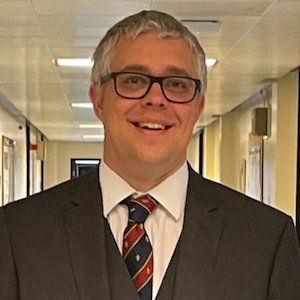Article
3-Year Data Suggest Azathioprine Lacks Clear Benefit in Thyroid Eye Disease
Author(s):
Three-year results from the CIRTED trial reported no clear evidence of benefit for the addition of azathioprine to high dose oral steroid in individuals with moderate to severe TED.
Peter Taylor, MBChB
Courtesy of Twitter

The CIRTED trial recently released its 3-year findings, indicating no clear evidence of benefit beyond the effect of high-dose oral steroids in individuals with moderate to severe Graves Orbitopathy, or thyroid eye disease (TED), randomized to recieve azathioprine or radiotherapy.1
Despite the various medical interventions utilized, patient outcomes at the 3-year mark were widely varied and often poor, particularly when it came to the Graves Ophthalmology Quality of Life (GOQOL) appearance scores. Yet, investigators from Cardiff University noted that a large proportion patients still required surgery and could potentially see improvements in GOQOL visual function scores down the line.
“Despite considerable effectiveness of therapy in improving Graves Orbitopathy indices such as Clinical Activity Score (CAS), this is not reflected in quality-of-life scores and future trials of treatment and treatment strategies should reflect this,” wrote the investigative team led by Peter Taylor, MBChB.
Approximately 5 – 10% of patients with Graves’ disease are affected by active moderate-to-severe Graves Orbitopathy, a condition that can be visually disabling and cosmetically disfiguring. Current therapeutic strategies focus on reducing orbital inflammation, but follow-up data from clinical trials is limited to 18 months. Surgical interventions are typically delayed until a year post-diagnosis, but it remains unclear what proportion of patients will require surgery
As a result, Taylor and colleagues have indicated the crucial need for extended data to establish which TED characteristic is linked to poor clinical outcomes once the inflammatory phase of the disease has resolved. The CIRTED Trial randomized patients with TED receiving high dose oral corticosteroids to receive either azathioprine or placebo and orbital radiotherapy or sham radiotherapy. Results from the trial were previously reported at 1 year, but participants were invited to attend an optional follow-up assessment at 3 years.
Follow-up data at 3 years were available for 68 of 126 (54%) individuals initially randomized in the CIRTED study. After 3 years, the CIRTED study investigators found that no clear benefit was observed in Binary Clinical Composite Outcome Measure (BCCOM) for those who received azathioprine in addition to high dose oral steroids, versus placebo (adjusted odds ratio [aOR], 0.51; 95% confidence interval [CI], 0.08 – 3.13; P = .47). Similarly, there was no significant difference observed between orbital radiotherapy versus sham radiotherapy (aOR, 2.17; 95% CI, 0.43 – 10.9; P = .35).
Furthermore, the study suggested that neither azathioprine nor orbital radiotherapy demonstrated any additional benefits beyond high dose oral steroids in terms of Ophthalmology Index and no interactions on their effect. Those randomized to azathioprine had an adjusted Beta (Badj) of 1.33 (95% CI, –0.68 to 3.34; P = .19) on OI and those randomized to orbital radiotherapy had a Badj of 0.11 (95% CI, –1.93 to 2.13; P = .92).
In the data, investigators found no noticeable differences in change in CAS between those who received azathioprine versus placebo (Badj, 0.58; 95% CI, –0.20 to 1.36; P = .14) or radiotherapy versus sham radiotherapy (Badj, 0.58; 95% CI, –0.58 to 0.98; P = .61). The team also indicated that there was no difference in improvement in EUGOGO scores between individuals randomized to azathioprine versus placebo or radiotherapy versus sham therapy.
Despite extensive medical therapy, the results indicate 37.5% of patients (n = 24) still required surgical intervention, predominantly lid surgery or decompression. The study revealed that a disease duration of greater than 6 months at baseline was associated with a higher likelihood of requiring surgery (OR, 16.8; 95% CI, 2.95 – 95.0; P = .001).
Those randomized to azathioprine did not see any significant improvements in visual function quality of life scores (P = .32) nor did those randomized to receive radiotherapy (P = .36). However, there was a potential advantage of radiotherapy in enhancing appearance scores. Overall, 35% of individuals failed to improve their GOQOL-VF scores and 42.4% failed to improve GOQOL-AP in 3 years, with even higher rates in those who did not undergo surgery.
“Longer term studies particularly for promising new therapies are needed, with an emphasis on quality-of-life measures and not just objective clinical assessments of Graves Orbitopathy,” investigators wrote.
References
- Peter Taylor, Rathie Rajendram, Stephanie Hanna, Victoria Wilson, Julie Pell, Chunhei Li, Anne Cook, Rao Gattamaneni, Nicholas Plowman, Sue Jackson, Robert Hills, Robert French, Jimmy M Uddin, Richard WJ Lee, Colin M Dayan, On behalf of the CIRTED investigators, Factors predicting long-term outcome and the need for surgery in Graves Orbitopathy: extended follow-up from the CIRTED Trial, The Journal of Clinical Endocrinology & Metabolism, 2023;, dgad084, https://doi.org/10.1210/clinem/dgad084





